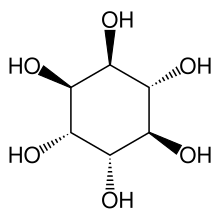The chemical compound 1L-chiro-inositol[2] (often called L-chiro-inositol or LCI) is one of the nine stereoisomers of cyclohexane-1,2,3,4,5,6-hexol, with formula C6H12O6, the generic "inositol". Its molecule has a ring of six carbon atoms, each bonded to a hydrogen atom and a hydroxyl group (–OH). Imagining the ring is horizontal, the hydroxyls on carbons 1, 2, and 4, in clockwise order are above the respective hydrogens, while the other three are below them.

| |
| Names | |
|---|---|
| IUPAC name
1L-chiro-Inositol
| |
| Systematic IUPAC name
(1R,2R,3R,4R,5S,6S)-Cyclohexane-1,2,3,4,5,6-hexol | |
| Other names
(-)-1,2,4/3,5,6-inositol
L-(−)-chiro-Inositol | |
| Identifiers | |
3D model (JSmol)
|
|
| ChEBI | |
| ChemSpider | |
| ECHA InfoCard | 100.008.183 |
| UNII | |
| |
| |
| Properties | |
| C6H12O6 | |
| Molar mass | 180.156 g·mol−1 |
| Melting point | 230 °C (decomposes) [1] |
| 485 g/L [1] | |
Chiral rotation ([α]D)
|
20/ −60°, c=1.3 in H2O [1] |
Except where otherwise noted, data are given for materials in their standard state (at 25 °C [77 °F], 100 kPa).
| |
The compound occurs in the human body and other organisms, together with its enantiomer (mirror image isomer) 1D-chiro-inositol (DCI), but at a much lower concentration than the main isomer myo-inositol.
Structure
editL-chiro-inositol crystallizes in the monoclinic system, group P21, with cell dimensions a = 686.7 pm, b = 913.3 pm, c = 621.7 pm (±0.004 pm) angle β = 106.59° (± 0.04°), molecular count Z = 2. The molecule has the expected chair conformation, with puckering parameters Q = 56.1 pm, θ = 4.4°, φ = 51.2°. The non-hydrogen molecular symmetry is close to C2. The C–C bond lengths range from 151.5 to 152.8 pm, and the C–O bond lengths from 141.8 to 143.6 pm. The C–C–C angles range from 109.7 to 113.1°, and the C–C–O angles from 106.5 to 112.0°.[3]
Laboratory synthesis
editL-chiro-inositol can be prepared from myo-inositol.[4] It can be prepared also from para-benzoquinone by enzymatic action on a derived conduritol B intermediate;[5] or by controlled oxidation of cyclohexa-3,5-diene-1,2-diol.[6][7]
Another viable method is decomposition of plant-sourced quebrachitol, which can be obtained in good quantity from natural rubber serum (NRS), the liquid remaining from coagulation of latex from Hevea brasiliensis.[8]
Natural occurrence
editL-chiro-inositol occurs, together with the D- isomer, in phospholipids of animal tissues. Analysis of rat tissues shows predominance of DCI in fat, liver, brain and kidney, and approximately equal amounts of DCI and LCI in muscles. L-chiro-inositol is also found in plants and parasites as quebrachitol, an ester of LCI — specifically, 2-O-methyl-L-chiro-inositol.[9] [8]
L-chiro-inositol can be extracted from dead leaf material from the seagrass Syringodium filiforme that washes up as flotsam on Caribbean beaches. Yeld of 2.3–2.5% of dry weight has been reported.[10]
Microbial action in soil incubated for 12 days at 70% moisture converted about 4% of the at converted about 4% of infused myo-inositol to chiro-inositol of unspecified (D or L) optical activity.[11]
See also
editReferences
edit- ^ a b c Sigma-Aldrich (2024), "Product 468053: L-(−)-chiro-Inositol". Online catalog, accessed on 2024-06-31.
- ^ IUPAC Chemical Nomenclature and Structure Representation Division (2013). "P-104.2.1". In Favre, Henri A.; Powell, Warren H. (eds.). Nomenclature of Organic Chemistry: IUPAC Recommendations and Preferred Names 2013. IUPAC–RSC. ISBN 978-0-85404-182-4.
- ^ George A. Jeffrey, Younghee Yeon (1987): "The crystal structure of l-chiro-inositol". Carbohydrate Research, volume 159, issue 2, pages 211-216. doi:10.1016/S0008-6215(00)90216-7
- ^ M. Belén Cid, Francisco Alfonso, Manuel Martín-Lomas (2003): "L-chiro-inositol derivatives from myo-inositol. Building blocks for inositol phosphoglycans". Synlett, volume 2003, issue 9, pages 1370-1372. doi:10.1055/s-2003-40339
- ^ Michael Podeschwa, Oliver Plettenburg, Jochen vom Brocke, Oliver Block, Stephan Adelt, Hans-Josef Altenbach (2003): "Stereoselective synthesis of myo-, neo-, L-chiro, D-chiro, allo-, scyllo-, and epi-inositol systems via conduritols prepared from p-benzoquinone". European Journal of Organic Chemistry, volume 2003, issue 10, pages 1958-1972. doi:10.1002/ejoc.200200572
- ^ Larry E Brammer Jr., Tomas Hudlicky (1998): "Inositol synthesis: concise preparation of l-chiro-inositol and muco-inositol from a common intermediate". Tetrahedron: Asymmetry, volume 9, issue 12, 19 june , pages 2011-2014 doi:10.1016/S0957-4166(98)00182-7
- ^ Howard A. J. Carless, K. Busia, O. Z. Oak (1993): "Microbial oxidation of benzene as a route to inositol stereoisomers and (±)-quebrachitol". Synlett, volume 1993, issue 9, pages 672-674. doi:10.1055/s-1993-22567
- ^ a b Christine Sue Chen Lee, Manroshan Singh, Chin-Hoe Teh, Dazylah Darji, Azhar Ahmad & Zairossani Mohd Nor (2023): "Modification of quebrachitol extracted from natural rubber serum (NRS) to L-chiro-inositol for pharmaceutical and nutraceutical applications". Journal of Rubber Research, volume 26, pages 179–192 doi:10.1007/s42464-023-00218-2
- ^ Joseph Larner (2000): "D-chiro-inositol – Its functional role in insulin action and its deficit in insulin resistance". Journal of Diabetes Research, volume 3, pages 47-60. doi:10.1080/15604280212528
- ^ Gladys Nuissier a, Faïza Diaba b, Micheline Grignon-Dubois a (2008): "Bioactive agents from beach waste: Syringodium flotsam evaluation as a new source of L-chiro-inositol". Innovative Food Science & Emerging Technologies, volume 9, issue 3, pages 396-400. doi:10.1016/j.ifset.2007.12.002
- ^ Michael F. L'Annunziata, Juan González Iturbe, Luis A. Olivares Orozco (1977) "Microbial epimerization of myo-inositol to chiro-inositol in soil". Soil Science Society of America Journal, Division S-3 - Soil Microbiology and Biochemistry, volume 41, issue 4, pages 733-736. doi:10.2136/sssaj1977.03615995004100040024x